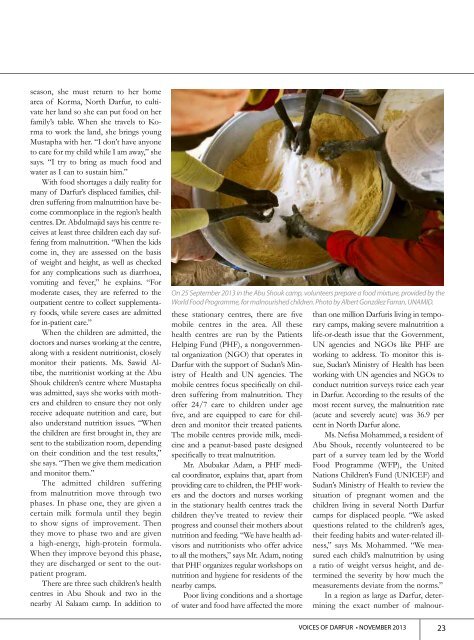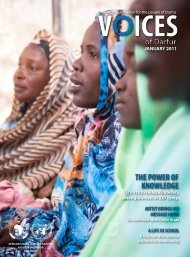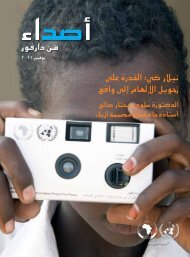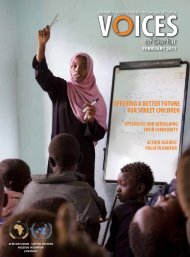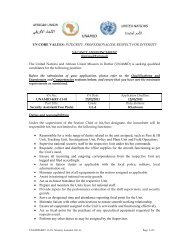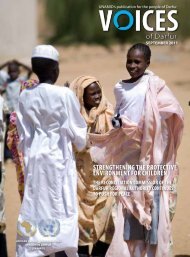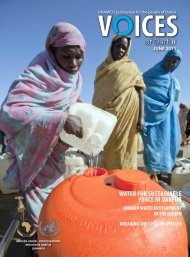Darfur Dances
Download the magazine (PDF) here. - Unamid
Download the magazine (PDF) here. - Unamid
- No tags were found...
Create successful ePaper yourself
Turn your PDF publications into a flip-book with our unique Google optimized e-Paper software.
season, she must return to her home<br />
area of Korma, North <strong>Darfur</strong>, to cultivate<br />
her land so she can put food on her<br />
family’s table. When she travels to Korma<br />
to work the land, she brings young<br />
Mustapha with her. “I don’t have anyone<br />
to care for my child while I am away,” she<br />
says. “I try to bring as much food and<br />
water as I can to sustain him.”<br />
With food shortages a daily reality for<br />
many of <strong>Darfur</strong>’s displaced families, children<br />
suffering from malnutrition have become<br />
commonplace in the region’s health<br />
centres. Dr. Abdulmajid says his centre receives<br />
at least three children each day suffering<br />
from malnutrition. “When the kids<br />
come in, they are assessed on the basis<br />
of weight and height, as well as checked<br />
for any complications such as diarrhoea,<br />
vomiting and fever,” he explains. “For<br />
moderate cases, they are referred to the<br />
outpatient centre to collect supplementary<br />
foods, while severe cases are admitted<br />
for in-patient care.”<br />
When the children are admitted, the<br />
doctors and nurses working at the centre,<br />
along with a resident nutritionist, closely<br />
monitor their patients. Ms. Sawid Altibe,<br />
the nutritionist working at the Abu<br />
Shouk children’s centre where Mustapha<br />
was admitted, says she works with mothers<br />
and children to ensure they not only<br />
receive adequate nutrition and care, but<br />
also understand nutrition issues. “When<br />
the children are first brought in, they are<br />
sent to the stabilization room, depending<br />
on their condition and the test results,”<br />
she says. “Then we give them medication<br />
and monitor them.”<br />
The admitted children suffering<br />
from malnutrition move through two<br />
phases. In phase one, they are given a<br />
certain milk formula until they begin<br />
to show signs of improvement. Then<br />
they move to phase two and are given<br />
a high-energy, high-protein formula.<br />
When they improve beyond this phase,<br />
they are discharged or sent to the outpatient<br />
program.<br />
There are three such children’s health<br />
centres in Abu Shouk and two in the<br />
nearby Al Salaam camp. In addition to<br />
On 25 September 2013 in the Abu Shouk camp, volunteers prepare a food mixture, provided by the<br />
World Food Programme, for malnourished children. Photo by Albert González Farran, UNAMID.<br />
these stationary centres, there are five<br />
mobile centres in the area. All these<br />
health centres are run by the Patients<br />
Helping Fund (PHF), a nongovernmental<br />
organization (NGO) that operates in<br />
<strong>Darfur</strong> with the support of Sudan’s Ministry<br />
of Health and UN agencies. The<br />
mobile centres focus specifically on children<br />
suffering from malnutrition. They<br />
offer 24/7 care to children under age<br />
five, and are equipped to care for children<br />
and monitor their treated patients.<br />
The mobile centres provide milk, medicine<br />
and a peanut-based paste designed<br />
specifically to treat malnutrition.<br />
Mr. Abubakar Adam, a PHF medical<br />
coordinator, explains that, apart from<br />
providing care to children, the PHF workers<br />
and the doctors and nurses working<br />
in the stationary health centres track the<br />
children they’ve treated to review their<br />
progress and counsel their mothers about<br />
nutrition and feeding. “We have health advisors<br />
and nutritionists who offer advice<br />
to all the mothers,” says Mr. Adam, noting<br />
that PHF organizes regular workshops on<br />
nutrition and hygiene for residents of the<br />
nearby camps.<br />
Poor living conditions and a shortage<br />
of water and food have affected the more<br />
than one million <strong>Darfur</strong>is living in temporary<br />
camps, making severe malnutrition a<br />
life-or-death issue that the Government,<br />
UN agencies and NGOs like PHF are<br />
working to address. To monitor this issue,<br />
Sudan’s Ministry of Health has been<br />
working with UN agencies and NGOs to<br />
conduct nutrition surveys twice each year<br />
in <strong>Darfur</strong>. According to the results of the<br />
most recent survey, the malnutrition rate<br />
(acute and severely acute) was 36.9 per<br />
cent in North <strong>Darfur</strong> alone.<br />
Ms. Nefisa Mohammed, a resident of<br />
Abu Shouk, recently volunteered to be<br />
part of a survey team led by the World<br />
Food Programme (WFP), the United<br />
Nations Children’s Fund (UNICEF) and<br />
Sudan’s Ministry of Health to review the<br />
situation of pregnant women and the<br />
children living in several North <strong>Darfur</strong><br />
camps for displaced people. “We asked<br />
questions related to the children’s ages,<br />
their feeding habits and water-related illness,”<br />
says Ms. Mohammed. “We measured<br />
each child’s malnutrition by using<br />
a ratio of weight versus height, and determined<br />
the severity by how much the<br />
measurements deviate from the norms.”<br />
In a region as large as <strong>Darfur</strong>, determining<br />
the exact number of malnour-<br />
VOICES OF DARFUR • NOVEMBER 2013<br />
23


